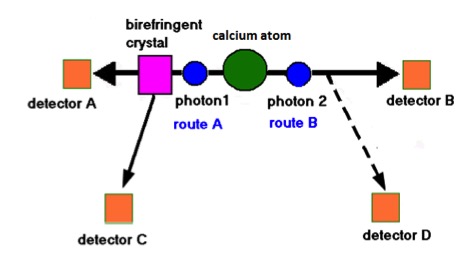
QUANTUM COMMUNICATION and QUANTUM ENTANGLEMENT
Quantum Teleportation is part of the study area known as Quantum Informatics. It is the set of calculation techniques and their study using “quanta” to store and process information.
According to Quantum Teleportation, it is possible to transfer the quantum state of a particle (for example, the state of polarization, in the case of a photon) to large distances. It is not the particle itself to be transferred but the “receiver” takes exactly the same state of polarization of the “transmitter”.
The Heisenberg’s Uncertainty Principle prohibits the exact knowledge of the state of the transmitted photon, but a property called “Entanglement” makes sure that this is not a problem for the teleportation. The effect involved in a Quantum Teleportation process is called “Quantum Entanglement”.
Quantum Teleportation does not imply transfer in the same way as in Star TreK, but through the phenomenon of Entanglement it is possible to transfer (instantly) “features” (quantum states) of photons, atoms, ions, in other photons, atoms, ions placed at any distance.
QUANTUM ENTANGLEMENT
The Quantum Entanglement was suggested for the first time in 1926 by Erwin Schrödinger, who was also the first to introduce in 1935 the term “Entanglement”. “Quantum Entanglement” is a quantum phenomenon, which has no classic equivalent. According to this phenomenon, each quantum state (e.g.: polarization of the photons, spin state of the electrons) of two or more physical systems depends on the state of each of them, even if they are spatially separated.
The Quantum Entanglement implies the presence of remote correlations between the observable physical quantities of the involved systems, so that the “non-local” character of quantum theory is established. According to the Entangled phenomenon, if two particles interact for a certain period of time and then they are separated, when one of them is stimulated, so that it changes its state, instantly a similar stress is manifested on the second particle, whatever the distance between the particles; in other words, the second particle changes instantaneously its state. The phenomenon of Entanglement therefore violates the “principle of locality” in which what happens in one place cannot immediately affect what happens in another place.
Albert Einstein, despite the important contributions given to the quantum theory, never accepted that a particle could instantaneously influence another particle. Therefore he tried to prove that the violation of locality was only apparent, but, from time to time, his attempts were rejected by his opponents.
The Entanglement is often called “EPR effect”, from the initials of Albert Einstein, Boris Podolski and Nathan Rosen; they, in 1935, analyzed the consequences of the phenomenon on particles placed at great distances. The particles involved are also called “EPR pairs”.
In 1982 the physicist Alain Aspect, with a series of sophisticated experiments demonstrated the existence of Entanglement, and then the inconsistency of the position of Einstein.
In October 1998, the phenomenon of Entanglement was finally confirmed by the success of a teleportation experiment performed by the Institute of Technology (Caltech) in Pasadena, California.
A simple experiment about the “Phenomenon of Entanglement”
Two particles “twins” are launched in opposite directions. If the particle 1, during its journey, meets a magnet that deflects it upward, the particle 2, instead of continuing its trajectory in a straight line, deflects its direction at the same time, assuming a motion contrary to that of the particle 1:

This experiment demonstrates that:
the particles are able to communicate each other by transmitting and processing information;
the communication is instantaneous.
The physicist Niels Bohr said: “Between two [related] particles that turn away from one another in space, there is a form of action - permanent communication. […]. Although two photons were located on two different galaxies they would still continue to remain one entity ...”
THE EXPERIMENTS OF ALAIN ASPECT
Alain Aspect, with the collaboration of the researchers J. Dalibard and G. Roger of the Optic Institute of the University of Paris, demonstrated the existence of the Entanglement, thus confirming the hypothesis of “non-locality” of the quantum theory.
The figure shows a simplified scheme of the equipment used by Aspect and his collaborators during the experiments. An excited atom of calcium, at the center of the figure, produces a pair of entangled photons that move along opposite paths “A and B”:

Along the path “A”, a birefringent crystal, that acts as a filter, is inserted from time to time. When the photon interacts with the crystal it can be deflected with a probability of 50%, or it can cross the crystal continuing undisturbed on its way. At the end of each path a photon detector is placed that allows the detection of the photons. The amazing thing that Aspect observed was that when, along the path A, the birefringent crystal was inserted and a deviation of the photon 1 occurred to the detector C, on the path B, also the photon 2 (without “obstacles” in front) deflected “spontaneously” and “instantly” toward the detector D. Basically, the act of introducing the birefringent crystal, with the consequent deviation of the photon 1, made instantly and remotely deflect the photon 2.
This might sound strange, but that's what actually happens when experiments on pairs of entangled particles are made. So the idea that entangled particles, located in distant places, represent separate entities, must be abandoned.
In reference to the uniqueness of the matter that stems from the “non localist” vision of quantum theory, Brian Josephson (the Nobel Prize for Physics) says: “The universe is not a collection of objects, but an inseparable network of vibrating energy patterns in which no single component has independent reality: including the observer”.